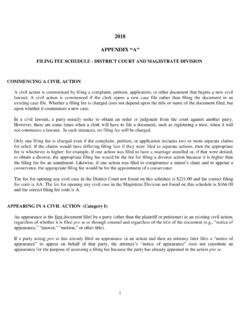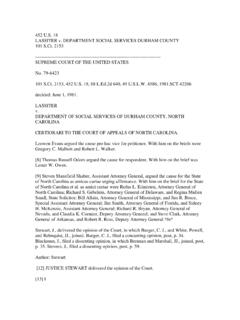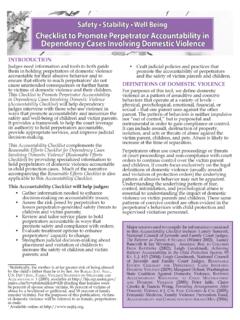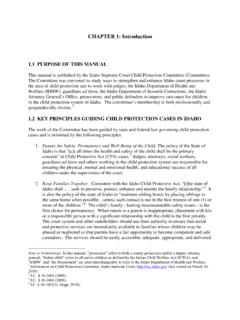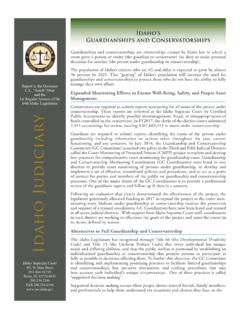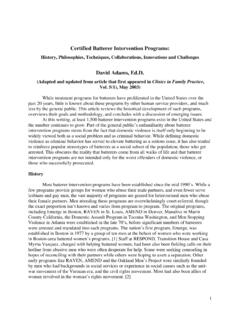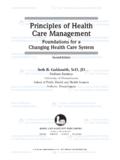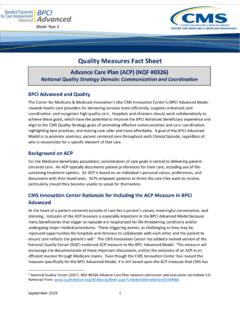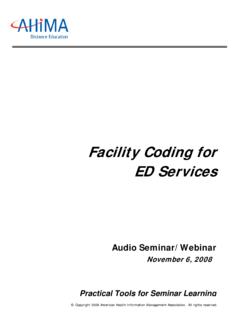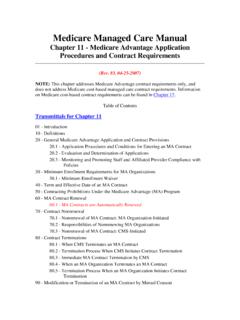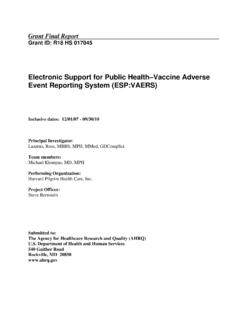Transcription of Overview of the Idaho Court System
1 Overview of the Idaho Court SystemI. STRUCTURE AND ORGANIZATION ..Page of Idaho s Judicial of Idaho s Court Districts and Regional Judges by Court and Type of OF THE COURTS ..Page protective act / Termination of Parental of of Incapacitated and Formal Estate Proceedings (probate) - Drivers License Suspension Corpus Case Types or ADMINISTRATION ..Page 9A. Administrative District Court Court Administrative Director of the Supreme Court Law , DISCIPLINE, AND REMOVAL OF JUDGES ..Page 12V. WHAT HAPPENS IN A CIVIL CASE? ..Page HAPPENS IN A CRIMINAL CASE? ..Page OF A TRIAL ..Page HAPPENS IN A CRIMINAL SENTENCING? ..Page investigation of HAPPENS IN A JUVENILE CORRECTIONS CASE?
2 Page 22X. WHAT HAPPENS IN A TRAFFIC CASE? ..Page ARE GRAND JURIES? ..Page 26 COUFT Overview SECTION II 1 Map of Idaho Judicial DistrictsIdaho's Integrated Court System2B. CHART OF Idaho 'S Court STRUCTURESUPREME COURTC hief Justice and four Associate Justices. Staggered terms of 6 years after non-partisan, at-large jurisdiction in:(1)Claims against State (advisory opinions)(2) Extraordinary writs*Appellate jurisdiction in:(1) Appeals from interim orders and final judgment in district courts(2) Direct appeals from certain administrative agenciesCOURT OF APPEALSC hief Judge and three Associate Judges. Staggered terms of 6 years after non-partisan, at-large statewide election. Jurisdiction limited to appeals from the district courts which are assignedby the Supreme Court .
3 *DISTRICT COURTS 41 district judges presently authorized. Terms of 4 years after non-partisan election within the judicial district. Voluntary retirement at age 65 (effective January 1, 1999). *MAGISTRATE DIVISIONS 87 magistrate judges authorized. Terms: Initial 18 months upon appointment by district magistrates commission; subsequent four year terms by county retention election. Jurisdiction, generally: (1)Civil actions, , personal injury, property disputes, contracts, etc.,to $10,000 (2)Small claims (3)Traffic cases Original jurisdiction over civil and criminal cases including: (1) Personal injury & other civil claims (2) Contracts (3) Property Disputes (4) Felonies Appellate jurisdiction: (1) Appeals from Magistrates Division (2) Appeals from state agencies and boards (3) Appeals from small claims departments (4)Probate of decedent estates (5)Juvenile correctionproceedings (6)Child protective proceedings (7)Misdemeanors (8)Arrest warrants;searches and seizures (9)Preliminary hearingsfor probable cause on felony complaints (10)Domestic relationsSMALL CLAIMSDEPARTMENTS.
4 Magistrate judges sit forsmall Jurisdiction limited to civilactions up to $4,000 overdefendants within the Attorneys not allowed in thetrial of small claims No jury trials in small claimscases.* Indicates Court to which appeals are takenIdaho's Integrated Court DISTRICTS AND REGIONAL STRUCTUREThe Supreme Court , as the supervisor of the entire Court System , establishes statewide rulesand policies for the operation of its functions and that of the district state is divided into seven judicial districts, each encompassing four to ten counties. This regional structure is designed to delegate authority to the judicial districts and to insuretheir participation in policy decisions while maintaining uniform, statewide rules andprocedures.
5 An administrative district judge, chosen by the other district judges in the district, performs anumber of administrative duties in addition to handling a judicial case load. Theadministrative district judge, assisted by a trial Court administrator, manages Court operationsin the district, assigns judges to cases, and coordinates activities of the clerks of the recommendations for local Court budgets and facilities are made by the administrativejudge, as well as personnel decisions for the district. Local rules of practice and procedureare recommended to the Supreme Court by the administrative judge with the concurrence ofthe other district judges. The administrative judge also jointly supervises the deputy clerks ofthe district administrative judge additionally serves as chair of the district magistrates commission, arepresentative body of county commissioners, mayors, citizens, and private attorneys which,among other things, appoints magistrate judges to their initial terms of JUDGES BY Court AND TYPE OF JUDGES upreme JusticesCourt of JudgesDistrict JudgesMagistrate JudgesTotal Trial Judges / DistrictDistrict 's Integrated Court STRUCTUREI daho has a unified Court System , which means that all state courts are administered andsupervised by the Idaho Supreme Court .
6 The source of this authority is Article 5, Section 2of the Idaho State Constitution, which states: "The courts shall constitute a unified andintegrated judicial System for administration and supervision by the Supreme Court ". Just asthe Governor is the head of the executive branch of government, the Idaho Supreme Court isthe head of the judicial branch of government. However, the courts are unique in that theyare funded in part by the state of Idaho and by cities and counties. As an example, judgesare paid by the state while deputy Court clerks are county employees paid by the 's Integrated Court OF THE COURTSThe Idaho Supreme Court has original jurisdiction in claims against the state (rendering advisoryopinions), original actions where writs (legal orders to do or not to do something) are sought,and discipline actions involving the actions of attorneys.
7 By far the most visible responsibility of the Supreme Court , however, is hearing appeals ofdecisions from district courts, the State Public Utilities Commission and the IndustrialCommission. While appeals of criminal cases often attract press coverage, most appeals decidedby the Supreme Court are civil disputes involving sums of money, determinations of rightsrelating to contractual arrangements or family relationships. During calendar 1996, 51% ofSupreme Court appellate decisions involved civil appeals, 39% involved appeals on criminal casesand were agency appeals from the PUC and the Industrial Commission. Statisticalinformation regarding the Supreme Court is produced annually in its Annual Idaho Court of Appeals began deciding cases on January 4, 1982.
8 The Court consists ofthree judges who sit in a 3-judge panel to decide cases assigned to the Court of Appeals by theSupreme Court of Appeals has jurisdiction to hear all cases assigned to it by the Supreme Court . However, the Supreme Court may not assign cases involving claims against any state,extraordinary writs, appeals from the imposition of capital punishment, nor appeals from theIndustrial Commission or Public Utilities an appellant may petition the Supreme Court to rehear a Court of Appeals decision, theSupreme Court is not required to grant such a petition. During calendar year 1996, a total of 101petitions for review of Court of Appeals decisions were filed with the Supreme Court . Of thattotal only 7 petitions for review were granted by the Supreme Court .
9 As evidenced by thesedata, in most instances, decisions of the Court of Appeals are CourtsDistrict courts and district Court judges have jurisdiction over civil and criminal cases. Theydecide cases involving the most serious criminal cases, felonies, and typically hear civil caseswhere the amount of money in dispute exceeds $10,000. Civil damage actions usuallyinvolve personal injury, such as automobile negligence cases and contractual disputesbetween parties. District judges may also hear domestic relation cases, such as divorces andchild custody matters, but in most counties, such cases are handled by magistrate judges. District judges also hear post-conviction relief actions, in which a defendant is challenginghis/her conviction or incarceration.
10 District judges also hear appeals from decisions made bymagistrate judges. DivisionMagistrate judges hear less serious criminal matters, known as misdemeanors, and canhandle civil cases where the amount of money involved does not exceed $10,000. Magistrate judges also hold preliminary hearings to determine whether to bind over and senda defendant to the district Court for trial on a felony charge. Magistrate judges may alsoissue warrants of arrest and search warrants. Magistrate judges handle habeas corpusproceedings, probate cases (wills and estates), juvenile cases, and domestic relation cases,such as divorce, alimony, child support, and child 's Integrated Court System6 Magistrate judges also sit as judges in the "people's Court ", the Small Claims Department.
